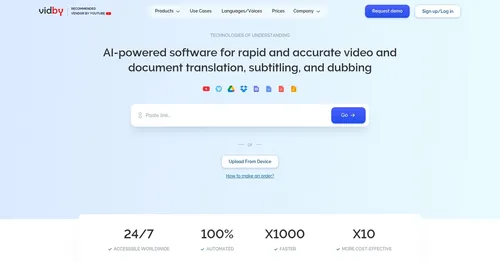Lara by Translated

I spent some time playing around with Lara Translate AI, pasting in some work emails and a short story to see how it held up. Right away, the clean dashboard caught my eye, no clutter, just a big text box and language dropdowns that load fast. I tried translating a tricky Italian recipe into English, and it nailed the steps, even suggesting “simmer gently” instead of a literal “cook slowly,” which made the whole thing read like a native cookbook. That contextual grasp surprised me, coming from its training on millions of pro-reviewed docs; it feels like having a quick-witted colleague glance over your shoulder.
Features wise, the three styles stood out during my session. Faithful kept my technical memo precise, no fluff added, while creative turned a bland product description into something punchy for ads. Document handling was smooth, I uploaded a PDF report and got back a formatted Word file without losing tables or bold text. It supports 200 languages, which covered my test from Spanish to Japanese effortlessly. Live mode for chats worked okay in a mock conversation, transcribing and translating on the fly, though it paused once to ask about a slang term, which was clever but slowed things a bit. Compared to DeepL, which I use sometimes, Lara felt more attuned to tone in creative bits, and versus Google Translate, it avoided those awkward word-for-word swaps that make sentences clunk.
Users might love the explanations feature, where it breaks down why it chose a phrase, like noting cultural fit for idioms. That’s empowering if you’re learning or verifying. The free plan let me do plenty without nagging upgrades, and security mentions full encryption, which eases worries for sensitive files. But here’s what bugged me: the character limit on free hit quick for longer docs, forcing a switch to paid, and no mobile app yet, so I had to stick to desktop. API integration sounded pro-level, but without my dev setup, I couldn’t test it fully. Pricing seems fair, free for basics, then team options comparable to competitors but with more customization baked in.
A fun twist was how it handled humor in my story snippet, preserving the joke’s punch better than expected, probably from that vast dataset capturing real-world tweaks. Witty observations like that make it addictive. On X and Reddit, folks rave about accuracy for business, though some note it’s newer, so community plugins lag behind established tools.
For your next project, try the fluid style first on sample texts to gauge fit, and build a simple glossary early to train it on your terms.
Video Overview ▶️
What are the key features? ⭐
- Contextual Translation: Analyzes full text for tone and intent to produce natural, accurate outputs.
- Translation Styles: Offers faithful, fluid, and creative modes tailored to content type like technical or marketing.
- Document Processing: Handles uploads of PDFs and Word files while maintaining original formatting.
- Ambiguity Detection: Flags unclear elements and seeks user input for refined results.
- API Integration: Enables embedding into apps with support for glossaries and real-time translation.
Who is it for? 🤔
Examples of what you can use it for 💭
- Localization Manager: Uses API and glossaries to translate website content while ensuring terminology aligns with brand guidelines.
- Freelance Writer: Applies creative style to adapt marketing copy for different cultures, preserving persuasive tone.
- Business Executive: Employs live interpreter for real-time meeting translations during international calls.
- Content Creator: Processes document uploads to convert blog posts into multiple languages with maintained formatting.
- Legal Professional: Selects faithful style for accurate rendering of contracts and technical terms.
Pros & Cons ⚖️
- High accuracy
- Contextual awareness
- Multiple styles
- Wide language support
- Free limits volume
- Fewer integrations
FAQs 💬
Related tools ↙️
-
 Camb.ai
An AI-powered platform that can transform how videos are dubbed and translated
Camb.ai
An AI-powered platform that can transform how videos are dubbed and translated
-
 OpenL
An AI-powered translation software that supports more than 100 languages
OpenL
An AI-powered translation software that supports more than 100 languages
-
 vidby
AI-powered software for video translation and dubbing into 70 languages
vidby
AI-powered software for video translation and dubbing into 70 languages
-
 O.Translator
An AI-powered document translation tool that supports more than 30 file formats
O.Translator
An AI-powered document translation tool that supports more than 30 file formats
-
AI Manga Translator Helping people read Japanese comics (aka manga) in their own language
-
 VMEG
An AI-powered video localization platform designed to help users translate, dub, and create videos
VMEG
An AI-powered video localization platform designed to help users translate, dub, and create videos

